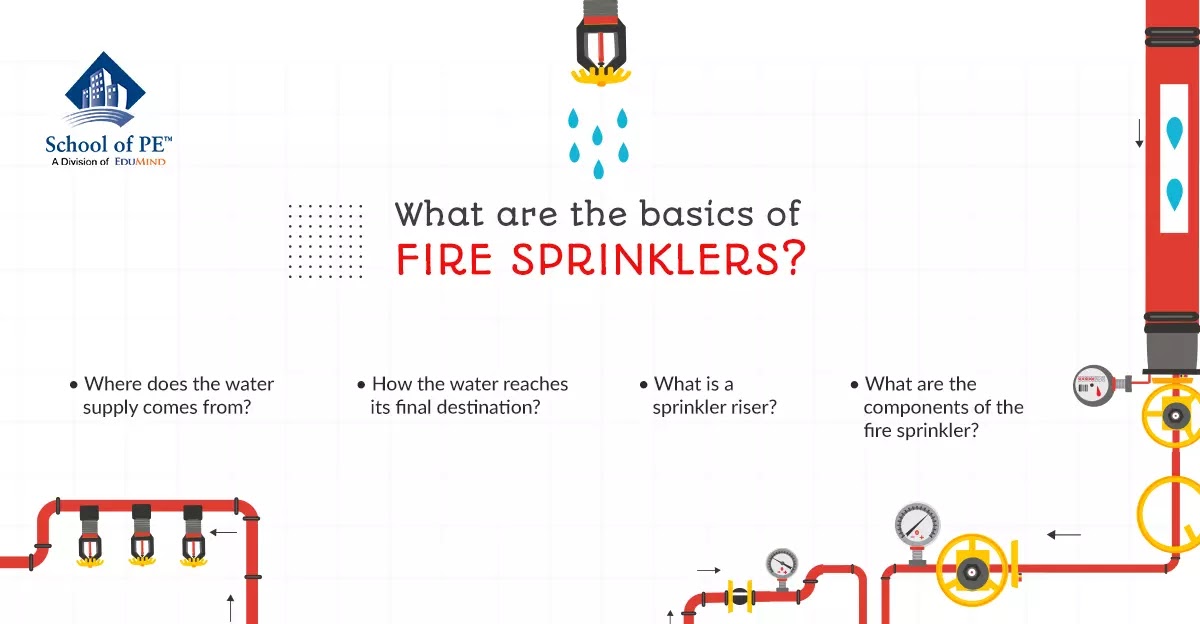One of the most important innovations in fire protection engineering has been automatic fire sprinkler systems, which not only save countless lives but also reduce the severity of fires across the globe. They are extremely effective in containing fires and allowing occupants time to escape as well as firefighters time to respond.
The first step in understanding sprinkler systems is knowing where the water supply comes from.
Sprinkler systems start with the water supply and end at the sprinkler head. The water supply can be a municipal water system, a water tank, or even a river or lake! The authority with jurisdiction determines what an adequate and reliable water supply looks like for their specific application. For instance, a fire sprinkler system for a dam might be able to use water from its own reservoir. Another example of an alternative water supply is a rural home with well water that can utilize its own water tank as a source for a fire sprinkler system.
The second step in understanding sprinkler systems is to recognize how the water reaches its final destination.
The next part of a fire sprinkler system is the piping from the source to sprinkler riser. This is usually done as underground piping but can also be done aboveground. Either way, the piping must be restrained properly, as the sudden force of a large volume of water can rip apart the piping, particularly at the bends. The bends are typically reinforced with concrete thrust blocks, a mechanical joint restraint, tie rods, or a combination of all three. An important consideration with underground piping is corrosion, but sacrificial anode bags can be used to delay the corrosion process. A backflow system is usually incorporated into the source piping to prevent contamination to the main source of water.

Next, you will want to know what the sprinkler riser is as well as its function in the fire suppression process.
The sprinkler riser is a vertical pipe that connects to the main branch of the sprinkler system and brings the water from the source piping to the overhead sprinkler system. The riser contains many parts, including a control valve, check valve, waterflow switch, a test drain, and various pressure gauges. The control valve is essentially a shut off valve that can be used to turn off the sprinkler system once the fire has been extinguished. The check valve prevents water from returning to the underground system. The water in the sprinkler piping is usually putrid as it has been in the system for many years without movement, and that water should not return to the source. The waterflow switch sends a signal to the fire alarm system when water is moving through the system. This indicates a serious situation and is usually transmitted to the dispatch center who will then get the fire department rolling to the site. The test drain allows an inspector to measure the flow and pressure from the system without actually setting off any heads. Pressure gauges show the working pressure of the system and tell the inspector if the system is still within its design parameters.
The first line from the riser is called the main line and is usually the biggest sprinkler piping line in the system. It diverges into branch lines which bring water to individual sprinkler heads. The main and branch lines need to be properly restrained in the event of an earthquake or waterflow. As mentioned earlier, the sudden shock of high-volume water flow produces large forces on the piping which can break apart the entire system, so the piping is held in place by braces and hangers that are designed to withstand the force of flowing water.
The last step of understanding the basics of fire sprinkling systems is knowing the components of the fire sprinkler itself.
The fire sprinkler itself consists of a fusible element that breaks when heated to a certain temperature, which then releases a plug holding back the water. Once the water is released, it hits a deflector which creates a water spray pattern that will help control the fire. The amount of water and spray pattern is dependent on the hazard and is determined by the fire protection engineer. Most sprinkler systems have this type of sprinkler head that will only activate if it is exposed to heat, so the Hollywood trope of the entire sprinkler system going off in a building is entirely inaccurate!
Interested in fire protection engineering? Check out School of PE's fire protection engineering exam review course!
No comments :
Post a Comment